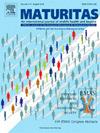绝经后妇女的膳食模式与死亡风险:一项基于人口的研究
IF 3.6
2区 医学
Q2 GERIATRICS & GERONTOLOGY
引用次数: 0
摘要
目的绝经过渡期增加了女性患慢性病的风险。考虑到饮食在健康中的关键作用,我们确定了饮食模式,可以解释绝经后妇女主要健康问题相关因素的变化。此外,我们还探讨了它们与全因死亡率和心血管死亡率的关系。研究设计:本研究纳入了以人群为基础的鹿特丹研究中的1814名绝经后妇女。主要结果测量:采用降秩回归确定饮食模式。反应变量包括骨密度、身体成分参数、脂质指标、胰岛素抵抗、收缩压、认知功能、抑郁和睡眠质量。使用Cox比例风险模型评估与死亡风险的关联。结果第一种饮食模式的特点是摄入更多的蔬菜、全谷物、豆类、坚果、咖啡、茶、酒精饮料和奶酪,解释了2.95%的反应变化,占g因子捕获的一般认知功能变化的12.11%,占收缩压变化的5.62%,占骨密度变化的4.13%,并与较少的肥胖、较低的血压、脂质标志物和胰岛素抵抗相关。第二种饮食模式的特点是摄入更多的加工肉类、未加工的红肉、家禽、鸡蛋和咖啡,摄入更少的糖果和茶,解释了1.54%的反应变化,占脂肪质量百分比变化的5.45%,占瘦质量指数变化的3.47%,占骨矿物质密度变化的3.29%,并与较高的肥胖、胰岛素抵抗和脂质标志物相关。在调整了人口统计学、社会经济地位、生活方式、病史和药物使用等混杂因素后,未发现与死亡风险的关联。结论:我们确定了饮食模式,解释了一系列与绝经后健康相关的健康因素的变化。虽然这些饮食模式解释了一些个体因素的巨大差异,但它们同时解释了多个风险因素的综合差异,并且没有观察到与死亡风险的显着关联。本研究为今后的研究提供了基础,旨在确定最佳的饮食模式,整合各种健康方面,以改善绝经后人群的健康。本文章由计算机程序翻译,如有差异,请以英文原文为准。
Dietary patterns derived using reduced rank regression in postmenopausal women and risk of mortality: A population-based study
Objectives
The menopause transition increases the risk of chronic conditions in women. Given the crucial role of diet in health, we identified dietary patterns that explain variations in factors related to major health concerns in postmenopausal women. Also, we explored their association with all-cause and cardiovascular mortality.
Study design
This study was conducted on 1814 postmenopausal women from the population-based Rotterdam Study.
Main outcome measures
Dietary patterns were identified using reduced rank regression. Response variables included bone mineral density, body composition parameters, lipid profile markers, insulin resistance, systolic blood pressure, cognitive function, depression, and sleep quality. The associations with risk of mortality were assessed using Cox proportional hazard models.
Results
The first dietary pattern, characterized by higher intake of vegetables, whole grains, legumes, nuts, coffee, tea, alcoholic beverages, and cheese, explained 2.95 % of the variation in responses, accounted for 12.11 % of the variation in general cognitive function captured by G-factor, 5.62 % in systolic blood pressure, and 4.13 % in bone mineral density, and was correlated with less adiposity, lower blood pressure, lipid markers, and insulin resistance. The second dietary pattern, characterized by higher intakes of processed meat, unprocessed red meat, poultry, eggs, and coffee, and lower intakes of sweets and tea, explained 1.54 % of the variation in responses, accounted for 5.45 % of variation in fat mass percentage, 3.47 % in lean mass index, and 3.29 % in bone mineral density, and was correlated with higher adiposity, insulin resistance, and lipid markers. No associations with mortality risk were identified after adjusting for confounders such as demographics, socioeconomic status, lifestyle, disease history, and medication use.
Conclusions
We identified dietary patterns explaining a range of variation in health factors related to postmenopausal health. While these dietary patterns explained a large variation in some of the individual factors, their combined explained variation across multiple risk factors simultaneously was limited and no significant association with mortality risk was observed. This study provides a foundation for future research aimed at identifying optimal dietary patterns, integrating diverse health aspects, to improve health in postmenopausal populations.
求助全文
通过发布文献求助,成功后即可免费获取论文全文。
去求助
来源期刊

Maturitas
医学-妇产科学
CiteScore
9.10
自引率
2.00%
发文量
142
审稿时长
40 days
期刊介绍:
Maturitas is an international multidisciplinary peer reviewed scientific journal of midlife health and beyond publishing original research, reviews, consensus statements and guidelines, and mini-reviews. The journal provides a forum for all aspects of postreproductive health in both genders ranging from basic science to health and social care.
Topic areas include:• Aging• Alternative and Complementary medicines• Arthritis and Bone Health• Cancer• Cardiovascular Health• Cognitive and Physical Functioning• Epidemiology, health and social care• Gynecology/ Reproductive Endocrinology• Nutrition/ Obesity Diabetes/ Metabolic Syndrome• Menopause, Ovarian Aging• Mental Health• Pharmacology• Sexuality• Quality of Life
 求助内容:
求助内容: 应助结果提醒方式:
应助结果提醒方式:


